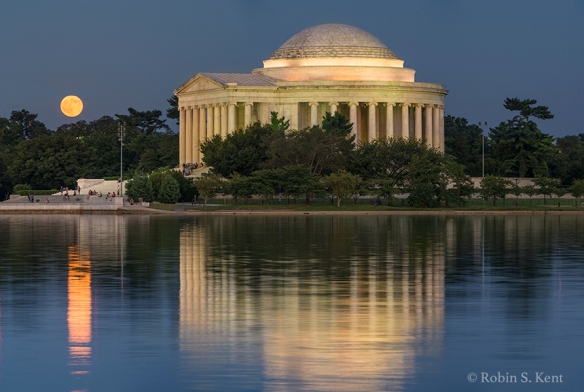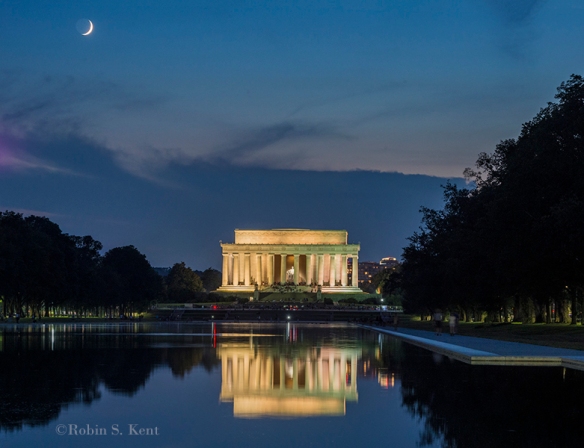In the first installment of this mini-series, I suggested including the moon in a night scene as a way to add interest and provided a few examples. In this segment, we’ll look at the moon in a little greater detail.
In the Washington, DC area, capturing images of a full moon rising has become increasingly popular, largely due to the availability of mobile “apps” to help you be at the right place at the right time. The general approach is to find a location from which one can photograph the moon perfectly positioned in relation to one of the major monuments. The image below was captured at the most popular of these locations, on a hill in Rosslyn, Virginia directly in front of the Netherlands Carillon.

Moonrise, Washington, DC (September 5, 2009)
An image like this is not as easy to obtain as it would appear, even with the help of an app like TPE (The Photographer’s Ephemeris). Aside from the obvious need for good weather, the time between the moonrise and sunset are critical as is the precise location of the moonrise. In the case of this image, it was actually taken on the night after the full moon. On the previous night, the weather was cloudy, the moonrise was 13 minutes before sunset and well to the right of the Lincoln Memorial. On the night of this image, the moonrise was 13 minutes after sunset at the perfect azimuth reading—85.5 degrees. This photograph was taken about 10 minutes later, very close to the end of civil twilight.
For those wanting to know when the next such opportunity comes, they might want to mark their calendars for October 15, 2016. It is the night before the full moon and the moon will rise 2 minutes after sunset. That’s a little closer than ideal, but the azimuth reading is close to perfect, at 84.1 degrees. Not as good as September 5, 2009, but worth a try if the weather is favorable.
A word of warning: You will be sharing this location with as many as 100 other photographers, all with tripods.
The Jefferson Memorial is probably the second most popular spot for a moonrise image, often attracting 30-40 photographers on a promising evening. The advantage here is there are more vantage points along the sidewalks of the Tidal Basin.

Moonrise, Jefferson Memorial (July 31, 2015)
(Technical notes: Moonrise 2 minutes after sunset at Azimuth 106.2 degrees; photograph taken 18 minutes after sunset.)
A similar alignment will occur on April 22, 2016 with a full moonrise 3 minutes after sunset at Azimuth 105 degrees.
One of the challenges in photographing a full moon is exposure. Once it gets well above the horizon on a clear night, an exposure chosen to capture a twilight scene will often result in an overexposed moon. This will happen even with illuminated buildings as the primary subject.

Jefferson Memorial, Full Moon and Fireworks (April 4, 2014)
(Technical notes: Moonrise 21 minutes after sunset at Azimuth 99.1 degrees, photograph taken 63 minutes after sunset.)
Tactics for resolving this issue can range from hoping for a light cloud cover to blending two separate exposures in Photoshop or using the HDR bracketed exposure procedure. Another method is to try for a crescent moon.

Crescent Moon with Lincoln Memorial (August 17, 2015)
Photographed 35 minutes after sunset. Note: In this case, the photograph is taken in same direction as the setting sun. Therefore, the twilight blue lasts longer than when you are pointing in the opposite direction.
Always consider possible locations when you travel. Apps like TPE can be really helpful if you check the destination before you go. For example, Mother Nature had kindly scheduled a full moon during our visit to Paris in 2014. A check with TPE revealed that it would be possible to have it in a picture with the Eiffel Tower.

Full Moon and Eiffel Tower (June 13, 2014)
(Technical Notes: Moonrise 8 minutes after Sunset at Azimuth 119.5 degrees. Photograph taken 50 minutes after Sunset. Twilight tends to last longer in Paris than in Washington, DC.)
The next full moon will be on February 22nd. Pick a spot and …
Keep Shooting….

Thanks for an informative post Robin. Great photos too!
LikeLiked by 1 person
Thanks very much. I’m glad you liked it.
LikeLike
Really beautiful Robin. I also love TPE but sometimes I’m all set up and then realize I’m off by a bit and then have to move. And it’s not always so simple is it! I really love these photos with the moon. They are picture perfect!
LikeLiked by 1 person
I know what you mean, Laura. It can be a problem when there isn’t much margin for error. But I can still remember not so long ago before TPE when a compass was the best device available. Of course, in those days, you didn’t see 100 photographers at the same location;-)
LikeLiked by 1 person
haha…too funny Robin. I’m laughing. Good way to start the day. 🙂
LikeLike
Such beautiful photos ~ all gorgeous but the one of the Jefferson Memorial gave me goosebumps!! Thank you for all the information. I’ll have to check out the TPE app once I practice my night photography.
LikeLiked by 1 person
Thanks, Patti: I appreciate that. Yes, it’s a pretty cool app. Also works for sunsets, sunrises, and figuring out when a subject is likely to be directly illuminated by the setting sun.
LikeLiked by 1 person
These are stunning photographs! The TPE app is very interesting – something worth taking an indepth look at.
LikeLiked by 1 person
Thanks! As I mentioned in another comment, you can look it up on one of those free YouTube tutorials and see how it works before deciding whether to buy it.
LikeLike
I’d not heard of TPE. Interesting! You offer excellent instruction without seeming like a textbook.
Your images are beautiful, with that moonrise at the Jefferson my favorite!
LikeLiked by 1 person
Thank you very much, that’s very kind to say. Yes, TPE is a pretty handy thing. There are lots of YouTube tutorials available to give you a better idea of how it works. I think it costs about $10 US and works on both smart phones and tablets. I pefer the tablet version; it’s easier to read the larger map.
LikeLike
Great post, as always. I just got back from Florida again. Now that I am home I am longing for warmer temps so I can get back out with my camera. I’ll have to check out the tutorials on YouTube. I bought TPE a while back, but certainly haven’t mastered it!
LikeLiked by 1 person
Thanks very much. I think you may returned home just in time for a good-sized snowfall;-) I can’t claim to have mastered TPE yet, but I keep practicing. I was all set up to do a Crescent Moon tonight, but there is this little problem of snow and rain that decided to appear today. I’ll need to figure out a Plan B, I guess.
LikeLike